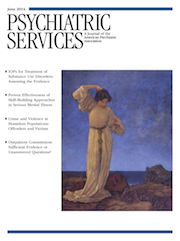Timing and Momentum in VA’s Path Toward Housing First: In Reply
In Reply: Dr. Tsai helpfully expresses key issues related to the adoption of Housing First in the VA context, where “readiness for change” was enabled by a major push from VA national leadership coupled with a dramatic expansion of resources to support the effort.
For communities considering Housing First as a new approach, the scale of VA’s expansion of Housing First may be even more instructive than the timing and momentum of VA’s efforts. To date, Housing First has been advanced primarily through model programs in cities with strong local leadership (individual, agency, or continuum of care) and adequate resources. But at this time, the U.S. Interagency Council on Homelessness seeks to end homelessness nationally, formally endorsing Housing First across communities at varying stages of readiness and perhaps with fewer available resources (1). Our article sought to portray some of the challenges these communities might face as they undertake such an effort, emphasizing most crucially that Housing First is not “housing only” but rather requires intensive clinical and support services coupled with a philosophical shift in values and practice.
Clinically, what communities might learn from the VA’s experience is that Housing First programs must sit within a broad portfolio of services assisting homeless individuals to escape the devastation of life on the streets. Community providers can be central in identifying individuals who would be best served by Housing First. The broader service network also complements Housing First programs and should continue to include primary care treatment programs, faith-based endeavors, mutual-support programs, Alcoholics Anonymous, and even residential drug treatment programs. But within that portfolio of services, Housing First must offer the sanctuary of permanent supportive housing—an independent, decent, affordable apartment and the support services (assertive community treatment or intensive case management or both) that match the needs and aspirations of each client with the right level of support to attain the client’s recovery goals.
Philosophically, Housing First is a sea change, a paradigm shift from clinician-driven to client-centered services. It offers housing as a matter of right, and it means turning over the power to make decisions and determine the sequence and pace of services to clients who until recently were labeled as noncompliant, not housing ready, or treatment resistant. These same clients are now selecting where and how they live as well as the type and sequence of services they receive. Data on their housing successes are reassuring (2).
As demonstrated in our article, this clinical and philosophical transition is not without challenges, but it is within reach (3).
1 Opening Doors: Federal Strategic Plan to End Homelessness. Washington, DC, US Interagency Council on Homelessness, 2010Google Scholar
2 : Alcohol and drug use disorders among homeless veterans: prevalence and association with supported housing outcomes. Addictive Behaviors 39:455–460, 2014Crossref, Medline, Google Scholar
3 : Housing first for homeless persons with active addiction: are we overreaching? Milbank Quarterly 87:495–534, 2009Crossref, Medline, Google Scholar



